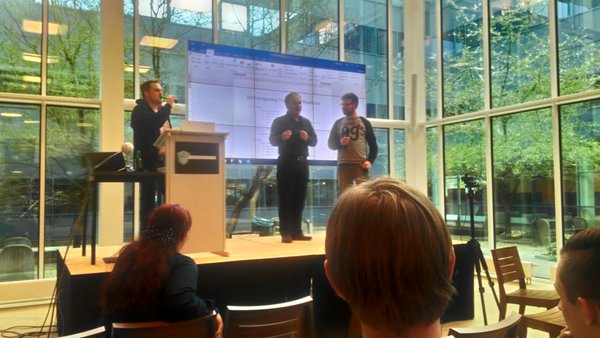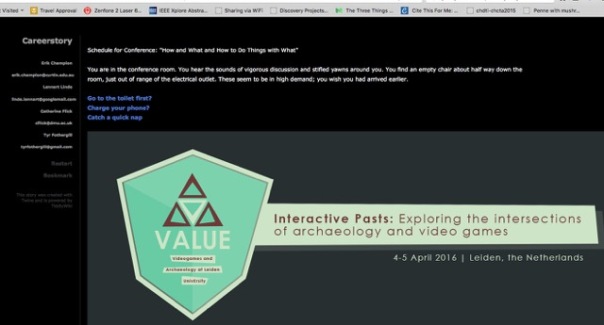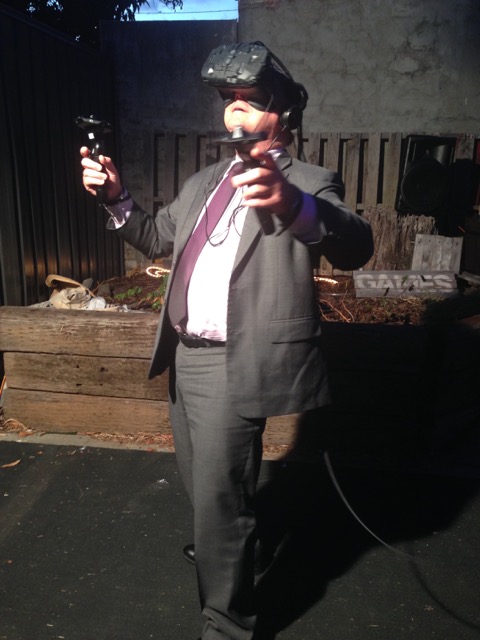Interactive Fiction
Over 4-5 April I attended the Interactive Pasts conference in Leiden, the Netherlands. It was organised by Archaeology PhD students, and they also created a gamified kickstarter project to get the funding required for an open access book publication of the proceedings. If you missed the conference (which was also on twitch), the presentations are on YouTube.
How does this relate to Interactive Fiction? Tara Copplestone and Angus Mol ran a workshop in the last session on interactive fiction.

Figure 1: #TIPC Interactive Pasts Conference Summary-Erik and Lennie photo by Tara Copplestone
Four of us (myself, Lennart Linde, Catherine Flick, B. Tyr Fothergill) used Twine (Mac version 1.42, PC is version 2.0), to develop the beginnings of an Interactive Fiction (IF) game, called A Career In Ruins, which is an archaeology conference simulator, where the student or junior researcher has to attempt to maximise their reputation while maintaining other important functions (such as phone battery and regular toilet breaks) without missing important sessions.

FIGURE 2: IF PROTOTYPE DEVELOPED WITH TWINE 1.4.2-A CAREER IN RUINS
Like many in the digital humanities, I was a fan of Steve Jackson Adventure Books in the 1980s (yes I was young then) and I had developed my own interactive fiction/D n D game on a 1628 byte CASIO FX-702P Programmable Calculator (around 1982?) I was very keen on expanding my knowledge of what these interactive writing tools can do.
Firstly there is a wide range of these tools: Google Docs.
Secondly, open source HTML-based TWINE and application INFORM are perhaps two of the most widely known tools (and TWINE is perhaps best to start with for beginners), but Squiffy (Mac, PC, Linux) looks most to interesting to me, and I was happy to discover that Adobe’s Phone Gap Application can port the Squiffy interactive fiction / games to mobile phones. I think HTML is a big advantage over those formats that require readers to download a specialised executable and HTML 5 also has other possibilities such as extending to JavaScript (three.JS, Angular.js Node.js or WebGL exported UNITY etc.). There are a variety of ways to create the 3D model for JavaScript and there are good tutorials online, the main challenge is how to incorporate 3D with interactive fiction.
There have even been IF-isometric driving games! The other possible advantages of the JavaScript that I mentioned are that they can offer videos, panoramas, and possibly 3D models.
About 10-15 years ago a program called RealViz allowed you to create 3D layers to panoramas, allowing movies and 3D objects to co-exist (would love to refind the Embarcadero example). Some exciting work and examples was done (via Shockwave 3D) with the imagemodeler but RealViz was bought out by Adobe and no longer exists. I don’t know of a comparable software application today.
However, using the above software I mentioned, I think we can link interactive fiction, panoramas, 3D models, and possibly even 3D panoramas with JavaScripted riddles (there are similar existing applications, like Pannellum).
It would be even more interesting to create these interactive-fiction panoramas for the new head mounted displays like the HTC Vive.

FIGURE 3: HTC VIVE, DEMO, LETS MAKE GAMES, PERTH
The possibilities for creative writing and also for archaeological story-making and cultural tourism really interests me and with European partners I hope we can propose a summer workshop. Possibly we would propose two workshops, one for creative writers and cultural tourism (using people’s own holiday snaps and other media, or drawing from digital archives of local heritage) and a second for archaeologists to create interactive fiction/fact/riddles/hypotheses. The first might combine lectures on Nordic Noir and its influence on cultural tourism. If the workshops actually take place, I think they would probably be in Denmark or Greece, or both. Best to start working on the proposal, then!
UPDATE: Inklewriter also looks promising according to this post of its use in a Choose Your Own Witchcraft Trial course.
